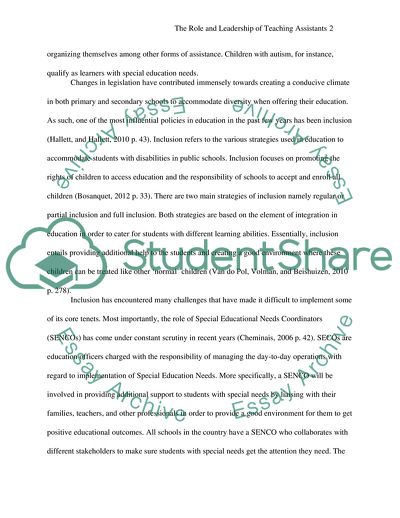Cite this document
(The Role and Leadership of Teaching Assistants - Special Education Coursework Example | Topics and Well Written Essays - 3000 words, n.d.)
The Role and Leadership of Teaching Assistants - Special Education Coursework Example | Topics and Well Written Essays - 3000 words. https://studentshare.org/education/1874445-critically-discuss-the-role-and-leadership-of-teaching-assistants-in-the-light-of-inclusion-and-current-send-legislation-and-the-challenges-to-inclusion-faced-by-the-role-of-sencos
The Role and Leadership of Teaching Assistants - Special Education Coursework Example | Topics and Well Written Essays - 3000 words. https://studentshare.org/education/1874445-critically-discuss-the-role-and-leadership-of-teaching-assistants-in-the-light-of-inclusion-and-current-send-legislation-and-the-challenges-to-inclusion-faced-by-the-role-of-sencos
(The Role and Leadership of Teaching Assistants - Special Education Coursework Example | Topics and Well Written Essays - 3000 Words)
The Role and Leadership of Teaching Assistants - Special Education Coursework Example | Topics and Well Written Essays - 3000 Words. https://studentshare.org/education/1874445-critically-discuss-the-role-and-leadership-of-teaching-assistants-in-the-light-of-inclusion-and-current-send-legislation-and-the-challenges-to-inclusion-faced-by-the-role-of-sencos.
The Role and Leadership of Teaching Assistants - Special Education Coursework Example | Topics and Well Written Essays - 3000 Words. https://studentshare.org/education/1874445-critically-discuss-the-role-and-leadership-of-teaching-assistants-in-the-light-of-inclusion-and-current-send-legislation-and-the-challenges-to-inclusion-faced-by-the-role-of-sencos.
“The Role and Leadership of Teaching Assistants - Special Education Coursework Example | Topics and Well Written Essays - 3000 Words”. https://studentshare.org/education/1874445-critically-discuss-the-role-and-leadership-of-teaching-assistants-in-the-light-of-inclusion-and-current-send-legislation-and-the-challenges-to-inclusion-faced-by-the-role-of-sencos.


